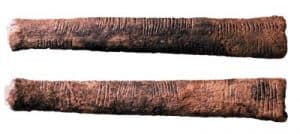PREHISTORIC MATHEMATICS
 |
The Ishango bone, a tally stick from central Africa, dates from about 20,000 years ago |
Our prehistoric ancestors would have had a general sensibility about amounts, and would have instinctively known the difference between, say, one and two antelopes. But the intellectual leap from the concrete idea of two things to the invention of a symbol or word for the abstract idea of “two” took many ages to come about.
Even today, there are isolated hunter-gatherer tribes in Amazonia which only have words for “one”, “two” and “many”, and others which only have words for numbers up to five. In the absence of settled agriculture and trade, there is little need for a formal system of numbers.
Early man kept track of regular occurrences such as the phases of the moon and the seasons. Some of the very earliest evidence of mankind thinking about numbers is from notched bones in Africa dating back to 35,000 to 20,000 years ago. But this is really mere counting and tallying rather than mathematics as such.
Pre-dynastic Egyptians and Sumerians represented geometric designs on their artefacts as early as the 5th millennium BCE, as did some megalithic societies in northern Europe in the 3rd millennium BCE or before. But this is more art and decoration than the systematic treatment of figures, patterns, forms and quantities that has come to be considered as mathematics.
Mathematics proper initially developed largely as a response to bureaucratic needs when civilizations settled and developed agriculture – for the measurement of plots of land, the taxation of individuals, etc – and this first occurred in the Sumerian and Babylonian civilizations of Mesopotamia (roughly, modern Iraq) and in ancient Egypt.
According to some authorities, there is evidence of basic arithmetic and geometric notations on the petroglyphs at Knowth and Newgrange burial mounds in Ireland (dating from about 3500 BCE and 3200 BCE respectively). These utilize a repeated zig-zag glyph for counting, a system that continued to be used in Britain and Ireland into the 1st millennium BCE.
Stonehenge, a Neolithic ceremonial and astronomical monument in England, which dates from around 2300 BCE, also arguably exhibits examples of the use of 60 and 360 in the circle measurements, a practice which presumably developed quite independently of the sexagesimal counting system of the ancient Sumerian and Babylonians.
<< Back to The Story of Mathematics Index | Forward to Sumerian/Babylonian Mathematics >> |
